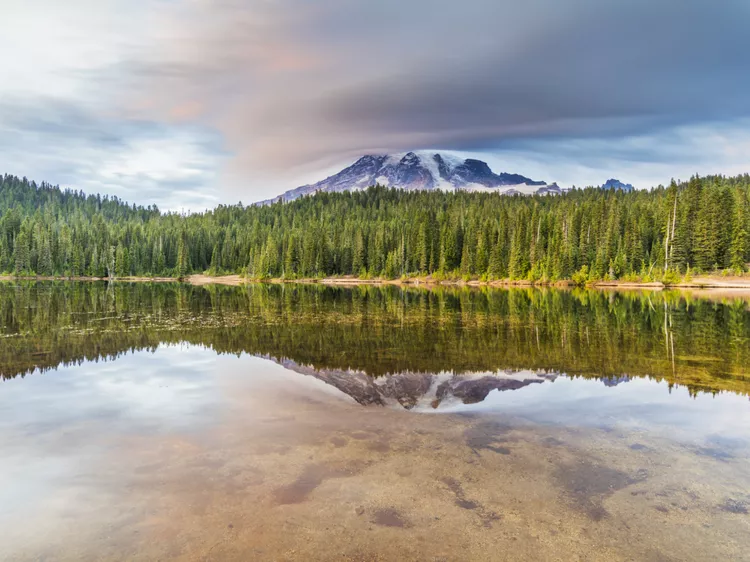Overview of Mount Rainier National Park
Mount Rainier is one of the world’s most massive volcanoes, renowned as one of the “Decade Volcanoes.” Towering at 14,400 feet, Mount Rainier is the tallest peak in the Cascade Range and serves as the centerpiece of Mount Rainier National Park. More than stunning vistas await visitors; the park offers a myriad of activities ranging from hiking through wildflower fields to observing ancient trees and listening to the sounds of cracking glaciers. It provides a unique outdoor experience, making it a must-visit destination.
History
Established on March 2, 1899, Mount Rainier National Park is one of the earliest national parks in the United States and the fifth national park overall. Approximately 97% of the park remains preserved as wilderness under the National Wilderness Preservation System. On February 18, 1997, it was designated a National Historic Landmark. Visitor numbers have surged from just over 1,700 in 1906 to about 2 million annually today!
When to Visit
The park is accessible year-round; however, your choice of season may impact your experience based on the activities available. For wildflower enthusiasts, July and August are optimal for viewing. Winter offers opportunities for cross-country skiing and snowshoeing. To avoid crowds during peak seasons, visiting mid-week is advisable. Always check weather conditions prior to your visit, as local weather around the mountain can vary significantly from city climates, impacting visibility and accessibility due to snow or closed roads.
Getting There
For travelers flying into the area, the nearest airports are located in Seattle, Washington, and Portland, Oregon. From Seattle, the park is approximately 95 miles away, while it’s about 70 miles from Tacoma. Take I-5 to State Route 7, then continue on State Route 706. Visitors coming from Yakima should take Highway 12 west to Highway 123 or Highway 410 to access the park from the east side. Those utilizing northeast entrances can travel via Highway 410 to 169 to 165, following the signs.
Fees/Permits
An entrance fee is required to access the park, valid for seven consecutive days. The fee costs $30 for a private, non-commercial vehicle or $15 for each visitor aged 16 and over entering by motorcycle, bicycle, horseback, or on foot. For repeat visitors, consider purchasing the Mount Rainier Annual Pass for $55, allowing unlimited access over the course of a year.
Things to Do
Mount Rainier National Park boasts exceptional experiences across scenic drives, hiking, camping, and mountain climbing. Depending on your visit timing, additional activities such as wildflower viewing, fishing, skiing, snowmobiling, and snowboarding can also be enjoyed. Before embarking on your adventure, explore the ranger-led programs offered, which vary daily in topics such as geology, wildlife, ecology, and park history, typically available from late June until Labor Day. Details can be found on the official NPS site.
Children can participate in Junior Ranger programs during summer weekends, with daily activities at Paradise. A Junior Ranger Activity Book is continuously available, and more information can be obtained at the Longmire Museum, reachable at (360) 569-2211 ext. 3314.
Major Attractions
Paradise:
Famed for breathtaking views and vibrant wildflower meadows, be sure to explore the following trails:
- Nisqually Vista Trail (1.2 miles)
- Skyline Trail to Myrtle Falls (1 mile) – Wheelchair accessible with assistance.
- Deadhorse Creek Trail & Moraine Trail (2.5 miles)
- Alta Vista Trail (1.7 miles)
Since the establishment of the park, Longmire has operated as the park’s headquarters, featuring historical sites like:
- Longmire Museum: Exhibits, information, and book sales.
- Christine Falls: A brief walk from the pullout provides classic views of the falls below the rustic stone bridge.
- Historic District Walking Tour: A self-guided tour showcasing rustic architecture.
- Eagle Peak Trail (7 miles): A steep path through ancient forests offering spectacular views of Mount Rainier, Nisqually Glacier, and the Tatoosh Range.
Sunrise: Reaching heights of 6,400 feet, Sunrise is the highest point accessible by vehicle in the park.
Carbon River: This section of the park, named for coal deposits, experiences significant rainfall, leading to plant communities resembling a temperate rainforest.
Accommodations
Within the park, six campgrounds are available: Sunshine Point, Ipsut Creek, Mowich Lake, White River, Ohanapecosh, and Cougar Rock. Sunshine Point is operational year-round, while others are open from late spring to early fall. Make sure to check campground conditions on the official NPS site before setting out.
For those preferring backcountry camping, permits are necessary and can be acquired at any visitor center, ranger station, or wilderness center. For a more comfortable stay, consider the National Park Inn and the historic Paradise Inn, both conveniently located within the park and offering affordable lodging and dining.
Contact Info
Mount Rainier National Park
55210 238th Ave. East
Ashford, WA 98304
(360) 569-2211





